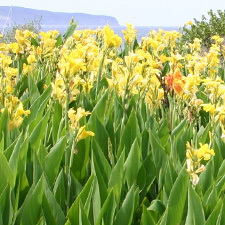 Canna lily
Canna lily
Common name: Canna lily
Botanical name: Canna indica
Management programme: Advisory
Originally from West Indies, Central and South America. It was introduced to New Zealand as an ornamental plant and was recorded as naturalised in 1870.
Why is it a pest?
- Forms tall, dense, long-lived stands that are tolerant to a range of conditions.
- Replaces all other plants on the ground, preventing revegetation, and often enables the establishment of other invasive weedy vines.
Where is it found?
- Prefers damp sites with high light in frost-free locations.
- Preferred habitat includes wetlands, river margins, gullies, disturbed shrublands, forest margins and coastal areas.
What does it look like?
- An erect, leafy perennial herb (less than 2m tall) with thick underground stems (rhizomes) and sturdy, unbranched, green and hairless above-ground stems from which large, green (sometimes purple tinged) oblong leaves grow.
- Pinkish-red to reddish-yellow and occasionally yellow or orange-red flowers grow from the top of the stem, often in pairs, and are followed by round seed capsules containing round black seeds.
What are the rules?
Advisory
Council does not enforce the control of advisory species. It is landowner/occupier responsibility to manage these pests. Council may provide advice on how to manage or control advisory species if required.
How do you get rid of it?
- Hand-pull (all year) – dispose of rhizomes by incineration, deep bury or refuse station.
- Dig-out (all year) – dispose of rhizomes by incineration, deep bury or refuse station.
- Cut and paste with herbicide.
- Foliage spraying (spring – summer).
CAUTION: When using any herbicide or pesticide, PLEASE READ THE LABEL THOROUGHLY to ensure that all instructions and directions for the purchase, use and storage of the product, are followed and adhered to.
Read more on pest control advice, information and regulations.
Images





